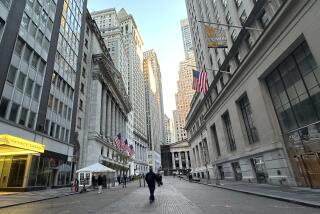U.S. Economy Shows New Vitality in August : Retail Sales Take Biggest Jump Since April; Inflation Static as Wholesale Prices Retreat
- Share via
WASHINGTON — The U.S. economy showed renewed signs of life last month with the biggest increase in retail sales since April and a modest gain in industrial production, the government said Friday.
Even with the pickup in economic activity, the Labor Department said, inflation stayed under wraps as wholesale prices took their steepest dive in 2 1/2 years.
The trio of reports, coming after earlier reports that unemployment in August had dipped to its lowest level in more than five years, had President Reagan singing the praises of the “miraculous powers of American enterprise.”
In a statement read by Beryl Sprinkel, chairman of the President’s Council of Economic Advisers, Reagan said the country stood ready to “unleash a decade of growth and create 10 million new jobs in the next four years.”
Some Not So Certain
Many private economists, while delighted with the August reports, were not as certain that they offer conclusive proof that the economy was finally emerging from its yearlong slump.
“Certainly August was a stellar month in terms of the economy’s performance, but it came after a terrible month,” said Allen Sinai, chief economist for Shearson Lehman Brothers. “There is not enough evidence yet to get overly optimistic about the future.”
The report on retail sales showed a 1.9% increase in August to a record $116.1 billion. The big gain, which came after a tiny 0.2% July increase, was attributed to a surge in auto sales, which rose 7.1% in August, the biggest one-month increase in almost three years.
However, analysts said much of demand for autos was spurred by the cut-rate financing deals offered by U.S. auto makers. They said that it is unlikely that the huge increase could be sustained in coming months.
Other analysts said that even without autos, retail sales were up a solid 0.4% and they predicted that consumer demand will grow even more in coming months.
“We see a strong pattern in retail sales, not only for autos, but across the board,” said Michael Evans, head of Evans Economics, a Washington-based economic forecasting firm. “We look for an even bigger non-auto gain in September.”
Wholesale Prices
Among other economic news:
--The Labor Department said wholesale prices fell 0.3% in August. The decline, the fourth in the last 12 months, left wholesale prices rising at an annual rate of 0.8% so far this year. Falling food and fuel costs were given the credit for the August drop.
--The Federal Reserve said industrial production rose 0.3% in August following no change at all in July. The August increase equaled the strongest one-month gain this year as the industrial side of the economy has been pounded by foreign competition. In the last 12 months, production has grown by only 1%, standing at 124.8% of its 1977 base at the end of August.
Sinai said it was “probably safe to say that the worst is over” for the industrial sector but he added it is not yet clear how strong of a rebound will occur.
--The Federal Home Loan Bank Board said rates on fixed-rate mortgages rose slightly in August to 12.62%, but were still well below levels earlier in the year. Adjustable rate mortgages continued to decline to 10.6%, the bank board said.
--The Mortgage Bankers Assn. said a survey found that the number of Americans behind by 60 days or more on their mortgage payments dropped to 1.83% in the April-June quarter, the lowest level in a year.
Wall Street Cool
The spate of economic news left Wall Street remarkably unimpressed and stock prices posted broad-based declines for a fourth straight day. Analysts said the new reports were not easing investor worries about the sluggish economy.
But Sprinkel, briefing reporters at the White House, said he viewed the new statistics as “more and more supportive of our expectations of renewed economic strength during the second half of the year.”
The Administration is predicting growth in the final six months of this year at an annual rate of almost 5%, far above the weak 1.1% rate turned in during the first half.
However, many private economists believe that the growth rate will not rebound to above 2.5% to 3% in the second half of the year as U.S. industry continues to be held back by a trade deficit, expected to reach $150 billion this year.
The Commerce Department said retail sales, while spurred primarily by auto demand, were up in a variety of areas.
Department store sales rose a strong 3.3% while specialty clothing stores, gasoline stations and drugstores posted smaller gains.
Sales were unchanged at building supply stores after a large 3.4% July gain.
More to Read
Inside the business of entertainment
The Wide Shot brings you news, analysis and insights on everything from streaming wars to production — and what it all means for the future.
You may occasionally receive promotional content from the Los Angeles Times.










